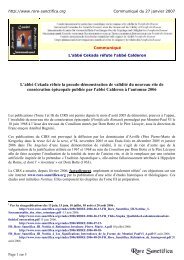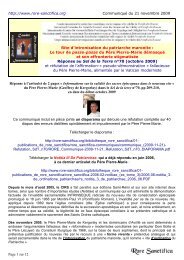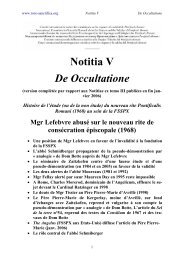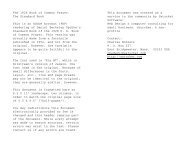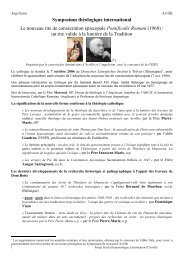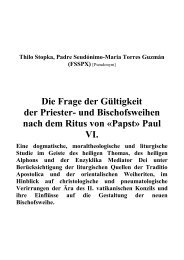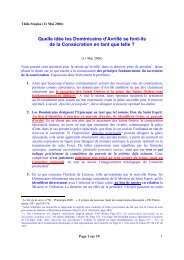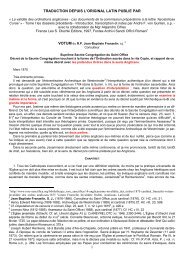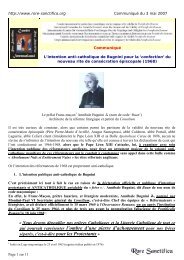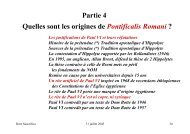THE ORDER OF MELCHISEDECH A Defence of ... - Rore Sanctifica
THE ORDER OF MELCHISEDECH A Defence of ... - Rore Sanctifica
THE ORDER OF MELCHISEDECH A Defence of ... - Rore Sanctifica
You also want an ePaper? Increase the reach of your titles
YUMPU automatically turns print PDFs into web optimized ePapers that Google loves.
The background to the new Ordinal lies in the fact that Cranmer invited Martin Bucer to stay with<br />
him for several months during the summer <strong>of</strong> 1549. Bucer's extreme Protestant views are referred to<br />
on p. 107, and also in Cranmer's Godly Order. Among the works which Bucer brought with him<br />
was one on ordination, De Ordinatione Legitima. Father Messenger notes that the Edwardine rite "is<br />
inspired throughout by Bucerian ideas, and that to an enormous extent it merely paraphrases or<br />
rather translates his Latin Lutheran rite". 3 The Rev. C. Smyth confirms from an Anglican<br />
standpoint that "it is almost certain that the function <strong>of</strong> the<br />
Commission was not to devise a new Ordinal, but to accept or suggest improvements to one that<br />
had already been drawn up, presumably by Cranmer and Ridley, on the basis <strong>of</strong> a draft made by<br />
Martin Bucer." 4<br />
The 1550 Ordinal was revised in 1552, the principal difference being found in the service for the<br />
ordination <strong>of</strong> a priest in which the ceremony for the delivery <strong>of</strong> the chalice and paten was removed.<br />
Even in the 1550 rite the signification <strong>of</strong> this ceremony had been reduced to giving authority to<br />
minister the Sacraments and not the power to <strong>of</strong>fer sacrifice.<br />
The two Ordinals were in use for about four years and were utilized for the ordination <strong>of</strong> a good<br />
number <strong>of</strong> priests and the consecration <strong>of</strong> six bishops: Poynet, Hooper, Coverdale, Scory, Taylor,<br />
and Harley. Another bishop, Ferrar <strong>of</strong> St. David's, had been consecrated before the issue <strong>of</strong> the 1550<br />
Ordinal but with an amended version <strong>of</strong> the Sarum Pontifical.<br />
MARY TUDOR<br />
When Queen Mary ascended the throne, and a reconciliation with Rome was effected, the Pope<br />
appointed Cardinal Pole as his legate. Among the many problems facing the Cardinal-Legate was<br />
the problem <strong>of</strong> the priestly ordinations and episcopal consecrations which had taken place during<br />
the schism. The clergy could, in the main, be placed in one <strong>of</strong> three categories:<br />
1. Those who had been ordained before the schism.<br />
2. Those ordained during the schism but according to the Pontifical.<br />
3. Those ordained according to the new Ordinal.<br />
With regard to the first and second classes, their ordination was certainly valid and all that was<br />
necessary was that they should be absolved from the guilt <strong>of</strong> schism and given the Church's<br />
authority to use the orders they had received. For this purpose dispensations would be needed but<br />
nothing more.<br />
With regard to the third class, the case was different. They had been ordained according to a rite<br />
which had not been approved by the Church and their status was a matter <strong>of</strong> admitting <strong>of</strong><br />
considerable doubt. There were a number <strong>of</strong> possibilities, some quite technical and complex, as to<br />
what precisely this status might be. The three most likely possibilities were:<br />
1. The ordinations could be accepted as valid and satisfactory.<br />
2. They could be accepted as <strong>of</strong> dubious validity and necessitate conditional reordination.<br />
3. They could be invalid.<br />
Cardinal Pole decided to ask for guidance from Rome before making his decision. The matter was<br />
entrusted to Thomas Thirlby, Bishop <strong>of</strong> Ely, who left for Rome in February 1555. He had been<br />
consecrated with the rites <strong>of</strong> the Pontifical during the reign <strong>of</strong> Henry VIII and therefore had full<br />
knowledge <strong>of</strong> all that had taken place under both kings. He had, moreover, made a public protest<br />
against the new Ordinal when it was introduced into the House <strong>of</strong> Lords. He carried all the relevant<br />
documents with him, including a Latin translation <strong>of</strong> the essential parts <strong>of</strong> the Anglican Ordinal.<br />
These documents are still filed in the Vatican archives.<br />
On 20 June 1555, Pope Paul IV issued his Bull Praeclara Charissimi in which he ruled that "those<br />
who have been promoted to Ecclesiastical Orders . . . by anyone but a bishop validly and lawfully<br />
ordained are bound to receive those Orders again." The Bull was received in England and duly<br />
promulgated, as is recorded in Cardinal Pole's register (preserved at Douai) under the date 22



